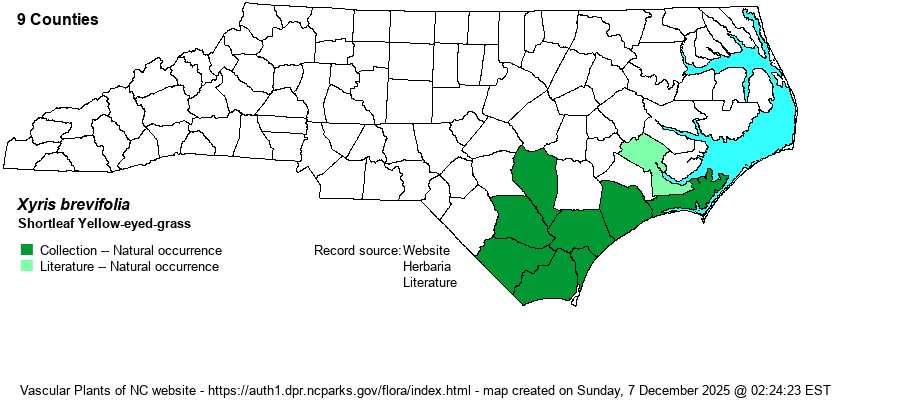| Author | Michaux | |
| Distribution | Southern middle and outer Coastal Plain, west only to Sampson, Bladen, and Columbus counties -- not ranging west to the Sandhills. The specimen from New Hanover County (at herbarium UNCA) lacks an image, so ID is not certain.
Coastal Plain, NC to southern FL and southern AL; W.I., S.A. | |
| Abundance | Uncommon. This is a Watch List species, as named by the NCNHP. | |
| Habitat | Moist or seasonally wet, acidic sand, usually with little competing vegetation, in Longlead Pine flatwoods; lower margins of Carolina bay rims. | |
| Phenology | Flowering and fruiting June-August. | |
| Identification | Shortleaf Yellow-eyed-grass is one of our smallest species, with leaves less than 7 cm (3 inches) long and at most 2 mm wide, and very small flowering heads. Usually several stems are produced per plant. The plant starts out green in late spring, but gradually turns rusty brown during flowering and fruiting period. Curtiss's (X. curtissii) and Savanna Yellow-eyed-grasses (X. flabelliformis) are about the same size, but both have obviously fan-shaped leaf arrangements and broader leaves. | |
| Taxonomic Comments | Members of Xyris are easy to identify to genus, but can be a challenge to identify species. Careful observation of a few features with a hand-lens is usually sufficient. Close attention must be paid to the flowering head, which is composed of overlapping brown scales. Immediately behind each scale are two brown "lateral sepals"; the margins of these may be feathery or irregularly lacerate (cut into narrow segments) or finely cut into short, comb-like prickles. Lateral sepals may be hidden or a bit longer than each scale. The flowers themselves are usually of little diagnostic value, other than time of flowering -- morning vs. afternoon. Seed size and ornamentation can also be useful characters, but require a dissecting scope to see well. Note also whether leaves and scapes (stems) are twisted and the color of the basal portion. All species have 2-ranked leaves, but in some species the leaves are arranged in a broad, fan-like shape. Finally, note the leaf and stem surface texture -- whether smooth of with little pale bumps. See Godfrey & Wooten (1979) for detailed descriptions and drawings. | |
| Other Common Name(s) | None | |
| State Rank | S3 | |
| Global Rank | G4G5 | |
| State Status | W1 | |
| US Status | | |
| USACE-agcp | OBL link |
| USACE-emp | OBL link |

